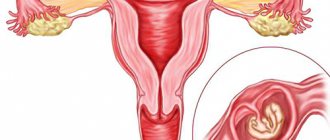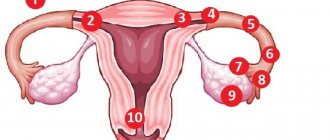About fetal freezing
Freezing of the fetus is a stoppage of its growth and death for any reason. Most often this happens at 3-4 and 8-11 weeks. It is at this time that the formation of the most important systems of the body occurs, and therefore the body of the unborn child becomes susceptible to infections. The causes of fading are:
- age. High risks are observed in primiparous women after 35-40 years;
- numerous abortions;
- previous frozen pregnancies;
- infectious lesions of the pelvic organs;
- STD;
- chronic kidney disease;
- hormonal imbalance.
In addition to the above, the embryo often stops developing after injuries suffered by the mother or while taking potent medications.
After 28 weeks, the percentage of freezing decreases significantly, however, if there are risks, the expectant mother should be under the supervision of a gynecologist until the moment of birth.
Possible complications
Fading pregnancy is a great stress for a woman, both physiological and moral. In this regard, cleaning causes various consequences. Some of them relate to normal processes associated with the resumption of the “pre-pregnancy” state. However, there are also those that indicate the development of pathology. What complications are possible after cleaning?
Delay of menstruation
A missed period is the most common complication of cleansing. Menstruation begins after 28–35 days in only half of women who have surgery. Reasons for delay:
- hormonal disbalance;
- stress;
- inflammatory processes of the reproductive organs;
- violation of surgical technique;
- accompanying illnesses.
Scanty discharge
Over the course of several cycles after cleansing, your period may take on the appearance of scanty or spotting discharge. The reason is that due to hormonal changes in the body, an insufficient amount of hormones is produced to form the endometrial layer. The uterine layer is thin, so during menstruation there is no active release of blood due to its rejection.
Also, the scarcity of discharge is explained by the lack of ovulation in the first 2 months after cleansing. A woman should pay attention when her period comes. If scanty periods appear later than expected, you should consult a doctor. This phenomenon is a sign of the development of pathologies of the ovaries, cervical canal or uterus.
Heavy periods
Heavy menstruation occurs as often as scanty discharge. Increasing the intensity of menstruation most often occurs due to hormonal imbalance. However, sometimes heavy discharge is an alarming sign. Possible pathological phenomena:
- development of infection in the uterine cavity;
- blood clotting disorder;
- poor-quality uterine curettage.
Painful sensations
After cleaning, due to fetal freezing, the uterus becomes more sensitive. Spasms during the expulsion of the endometrium intensify, so the woman feels pain in the lower abdomen. Painful sensations accompany menstruation for 2-3 cycles. However, during the recovery process, the sensitivity of the uterus decreases, and the pain subsides.
Approximately 3 months after the operation, the sensations return to normal. If your period continues to cause severe discomfort after curettage of a frozen pregnancy, you should consult a gynecologist, since pain is a sign of pathological phenomena. Menstruation requires special attention, which in addition to pain is manifested by intense bleeding.
Normally, during menstruation, no more than 80 ml of discharge per day should be released. Since it is difficult to measure the volume of this fluid, a woman should be guided by the frequency of changing the sanitary pad. If you have a heavy period, you should change the pad once every 2-3 hours. If bleeding occurs, the hygiene product becomes unusable within 1–1.5 hours.
Associated symptoms also indicate uterine bleeding:
- the appearance of clots more than 2 cm in diameter;
- blood color – dark red or scarlet;
- dizziness and general weakness;
- nausea and vomiting;
- fainting;
- cutting pain in the lower abdomen.
What to do?
First of all, you need to make sure that the embryo is really frozen. To do this, an external examination is carried out, which makes it possible to notice that the growth of the uterus has stopped. After this, an ultrasound and hCG tests are prescribed. The level of the hormone decreases during freezing. If the period is long, then the frozen embryo is indicated by the lack of its motor activity. If the diagnosis is confirmed, emergency curettage is prescribed. Menstruation after cleansing a frozen pregnancy is an indicator of health and full recovery of the body.
Menstruation after curettage of a frozen pregnancy
Important! The frozen embryo is scraped out as soon as possible, otherwise the decomposition products will provoke a serious inflammatory process in the uterine cavity.
How are your first periods after cleansing?
The first periods after a frozen pregnancy are often different from those before pregnancy. As a rule, they occur with a slight delay and last longer than usual. If the duration of menstruation before pregnancy was 3–5 days, then after a failed pregnancy they will last 5–7 days. In some cases, women notice spotting brown discharge for a week after the bleeding stops.
In the first days of menstruation, the body may react with a slight increase in body temperature. Sensations of painful spasms in the lower abdomen also appear. However, the pain should be tolerable. Sometimes the discharge becomes intense, but does not last long.
When does menstruation begin after curettage of a frozen pregnancy?
Restoration of regula after curettage of a frozen embryo occurs individually and depends on such aspects as:
- age of the frozen embryo;
- type of medical intervention;
- patient's age;
- the presence of hormonal disorders and chronic diseases.
In the early stages, when the embryo is frozen, vacuum cleaning is prescribed. This is the least traumatic procedure with minimal side effects. Menstruation after the procedure of vacuum aspiration of a frozen fetus occurs in 3-4 weeks. Sometimes the delay reaches 2 months.
In addition to vacuum aspiration, curettage of the contents of the uterus can be performed using special instruments. You should not wait for your period after curettage of a frozen fetus earlier than 2-3 months. The procedure requires a long rehabilitation period and restoration of hormonal levels. Restoring a cycle after a missed pregnancy is a long process that depends on many factors. If bleeding does not occur for more than 2 months or, on the contrary, heavy discharge is bothering you, you need to undergo an ultrasound and undergo a series of tests.
what causes the delay?
If, after cleaning a frozen pregnancy, the pregnancy does not improve, the doctor prescribes a repeat ultrasound. The absence of bleeding after 33 days or more is not considered a pathology, however, if the delay is much longer, we are talking about serious disorders. The most common reasons for delay:
- incomplete abortion;
- the presence of an inflammatory process;
- exacerbation of chronic processes of the uterus and ovaries.
Important! The most dangerous situation is considered to be incomplete curettage.
In this case, as a result of the decomposition of the remains in the uterus, extensive infection develops.
Frozen pregnancy and cleansing
Curettage according to indications during a frozen pregnancy or after an abortion always negatively affects the woman’s health, damaging the cervix and uterine cavity.
Therefore, it is necessary to understand when menstruation begins after cleansing and how to determine that it is not bleeding. First of all, if you suspect fetal freezing, you need to pay attention to the following signs:
- vaginal discharge mixed with blood;
- increased body temperature against a background of general malaise;
- pain in the lower abdomen;
- in the second trimester there is no movement from the fetus.
Consultation with a doctor is required for any of the suspicious symptoms; this will help to diagnose the pathology in time and avoid significant complications.
If there are no symptoms, then during a routine ultrasound examination, specialists can determine a frozen pregnancy and provide timely assistance. In the early stages, a blood test for hCG, with low levels, will allow one to suspect a pathological process. In the first trimester, the body can independently reject the fetus; up to the 8th week of gestation, a planned abortion is possible; in a later period, curettage will be required. The situation is associated with the fact that death and decomposition inside the womb lead to intoxication and blood poisoning.
Recovery after curettage takes a long period, since the uterine cavity is injured, and at least three months must pass before the woman can bear and conceive a child. For absolute restoration of the reproductive organs, doctors recommend using protection during sexual intercourse for 6 to 12 months.
Menstruation after treatment
The occurrence of the first menstruation after curettage of a frozen pregnancy is individual for each woman. It is important to monitor the amount of bleeding, as well as the nature of the discharge. Any deviations from the norm after removal of a frozen fetus require an urgent gynecological examination and a comprehensive examination.
scanty menstrual flow
After curettage of a frozen pregnancy, periods should not be scanty. Spotting indicates both an incomplete abortion and the development of inflammation. If an unpleasant odor has been added to the discharge and your health has worsened, this indicates an infection has entered the body.
heavy menstruation
The occurrence of heavy periods after cleansing a frozen pregnancy is a common occurrence. The volume of blood released depends on how heavy the menstruation was before curettage. If normal, bleeding after curettage of a frozen fetus gradually subsides, and its peak occurs in the first 2-3 days from the beginning of regulation. If the bleeding does not stop for a long time, you need to contact a gynecologist.
Can menstruation hurt after cleansing?
Pain during menstruation after cleaning occurs in half of women who have undergone curettage. Normally, discomfort should be tolerable. They may have a pulling or cramping character. Increased pain indicates pathology if the patient experiences symptoms such as:
- deterioration of health;
- temperature increase;
- increased discomfort;
- the presence of mucus or pus in the discharge.
If you have at least one of the above symptoms, you need to undergo a gynecological examination.
Timing of menstruation after surgery
It is impossible to bring a dead embryo back to life. Therefore, during a frozen pregnancy, it is necessary to get rid of it. If a woman does not have a miscarriage, then doctors resort to surgical intervention - curettage. Rehabilitation after such surgery proceeds individually.
Discharge after scraping
When does your period start after curettage? Immediately after surgery, minor bleeding is observed. They will stop in about 5-7 days. They cannot be considered menstrual periods. Based on the characteristics of such discharge, one can judge the success of the procedure.
Immediate consultation with a doctor is required in cases where a woman experiences the following symptoms after cleansing:
- spotting lasts more than 7 days;
- severe or sharp pain appears in the lower abdomen;
- discharge is excessively abundant or completely absent;
- increased body temperature or other symptoms of intoxication;
- the discharge contains pathological impurities or has a foul odor.
Successful healing of the uterine cavity is indicated by discharge, which gradually stops by 5-7 days. In recent days they may take on a brownish tint. This color indicates good blood clotting.
Dates of the first menstruation
Doctors cannot predict exactly when your period will begin after cleaning. Surgery disrupts the upper uterine layer (endometrium). It takes 25 to 31 days to recover. Such periods are individual for each woman and constitute one full menstrual cycle. Once the damaged lining of the uterus is repaired, natural rejection may occur. In other words, the first menstruation will come after a frozen pregnancy.
***
After curettage, a woman's cycle changes. This applies not only to cleansing, but also to spontaneous abortion. Now the first day of the menstrual cycle is the day of curettage (or miscarriage). Accordingly, menstruation should begin 25-35 days after surgery. If a woman’s body recovers well, then menstruation begins exactly as many days as the patient’s cycle lasts.
Delay of menstruation
Sometimes the first period after curettage does not come on time. After pregnancy, a woman's body experiences an imbalance of hormones. It will take time to restore their balance. This may take up to 2 months.
A delay in menstruation after curettage can be caused by the following:
- Fetal freezing in late stages. Typically, ST is fixed up to 13 weeks. But sometimes fetal death occurs in later stages. With a late termination of pregnancy, the damaged layer of the uterus will take longer to recover, so menstruation will come later.
- Condition of the body. Chronic inflammatory or infectious processes occurring in the reproductive system can provoke a delay in menstruation after cleansing. During surgery, the body is weakened, so diseases can worsen. This worsens the course of rehabilitation and increases the delay of menstruation.
- Age. According to statistics, pregnant women over 40 years of age are more likely to experience fetal death. They tolerate surgical interventions less well, and their body takes longer to recover.
- Psycho-emotional shocks. The stress experienced by a failed mother can disrupt the process of synthesis of necessary hormones. The more worried the patient is, the longer the delay may be.
- Incorrect treatment. Another reason why menstruation does not come on time after curettage of a frozen pregnancy may be improper hormone therapy. After curettage, the patient must be prescribed medication. It is aimed at restoring the body and protecting against new pregnancy. Sometimes (in rare cases) hormonal drugs are selected incorrectly, as a result of which the woman’s recovery significantly worsens.
- Complications after surgery. Any surgical intervention is fraught with unpleasant consequences. Most often, complications occur if the patient does not adhere to the doctor’s recommendations for rehabilitation. An increase in temperature signals an infection and inflammatory process.
***
If after cleansing you do not have your period for a long time, you should definitely come to an appointment with a gynecologist. Sometimes a delay can be caused not by one of the above reasons, but by a very dangerous situation - spasms of the cervix. In this case, blood discharge that does not receive a natural outlet accumulates in the uterine cavity. This is a dangerous condition that, if not treated in a timely manner, can result in removal of the uterus.
Pregnancy after miscarriage and cleansing: waiting for happiness
In theory, fertilization after curettage can occur in the next cycle, however, doctors do not recommend rushing to this event. The fact is that the mother’s body needs at least 6 months to recover. During this time, gynecologists recommend:
- take oral contraceptives;
- eliminate chronic diseases and pathological processes that led to the death of the fetus;
- undergo comprehensive treatment;
- take vitamins;
- normalize diet;
- undergo examination by an endocrinologist.
Planning a new pregnancy is possible after assessing the woman’s condition by the attending physician. When fertilization occurs after curettage, the expectant mother is obliged to carefully monitor her health and undergo regular examinations by a gynecologist.
How long does it take for menstruation to resume after curettage?
Discussions on the topic: “Menstruations after curettage” are a fairly common occurrence on women’s forums. Before we begin to consider this issue, we need to obtain a general understanding of curettage itself and the indications for it.
general information
A woman's uterus is a multi-layered muscular organ. When curettage, the inner mucous layer of the endometrium is removed. There are two types of scraping:
Separate cleaning is carried out blindly using tools. During this procedure, the uterus and cervical canal are cleaned. During hysteroscopy, a special device is inserted into the uterus, and the doctor observes how the endometrium is detached.
When will your period start after curettage? What is the norm and deviation? Why no menstruation after curettage? These questions should definitely be discussed with your doctor.
Discharge immediately after brushing
Menstruation does not appear immediately after curettage. Within a week after cleansing, a woman may observe discharge, which decreases every day. They appear due to trauma to the inner layer of the uterus. Bloody discharge that smoothly turns brownish is normal.
First menstruation after curettage
No one can answer for sure how long it will take for the menstrual cycle to be restored and for menstruation to begin. Returning the cycle to normal directly depends on the method of cleansing, the reason for which it was carried out, and the individual characteristics of the body.
effect of folic acid when planning pregnancy Ferretab
is a medicinal
product containing iron
and folic acid, and is used to eliminate the deficiency of these substances in the body or to prevent the occurrence of their deficiency
After diagnostic curettage, the time when menstruation should begin should not exceed six weeks. Menstrual
Source











